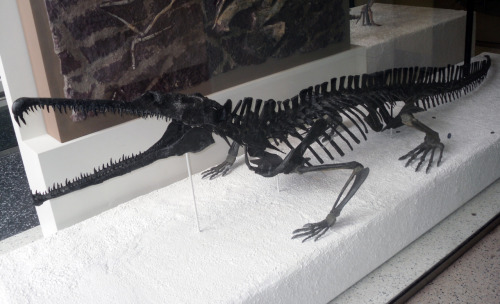Rutiodon Mounted specimen on display at the American Museum of Natural History, NYC Model on display
Rutiodon Mounted specimen on display at the American Museum of Natural History, NYC Model on display at Dinosaur State Park, Connecticut When: Late Triassic (~ 230 to 204 million years ago) Where: North America What: Rutiodon is a phytosaur. We have looked at another phytosaur before, Redondasaurus, which was one of the biggest and most derived of the phytosaurs. Rutiodon falls on the other end of the phytosaur family tree. Rutidon was about half (~25 feet/7.5 meters) as long as Redondasaurus, but as it was built so much more slenderly, it is more accurate to say it is only 1/3rd or even ¼th the size of its gigantic relative. This different body construction naturally translated into a different mode of life in Rutidon. Notice how slender and long its snout is? Some modern crocodiles have this same style of snout and they are predominately fish eaters, thus it is likely that Rutidon was as well, and it did not prey on terrestrial vertebrates. Phytosaurs strongly resemble modern crocodiles in other ways, and Rutiodon looks even more like a crocodile than many others of its kin. But this animal is most assuradly a phytosaur, /not/ a crocodile. One easy way to tell is if you look at the front end of its snout, look how the upper jaw is bent? That is a clear phytosaur feature. Another thing to look for is the position of the nose holes. Rutiodon has the phytosaur position of back near the top of its skull - whereas crocodiles have them in the more typically place at the end of the snout. Minor side trivia about this particular specimen of Rutiodon. It is number FR:AMNH 1, this means it was the first specimen to be catalogue into the fossil reptile collection. This specimen comes from a coal mine in Chatham County, North Carolina, and was collected by the famous paleontologist William Diller Matthew in 1895. -- source link
Tumblr Blog : dailyfossil.tumblr.com
#paleontology#geology#evolution#biology#fossil#north america#triassic#mesozoic#reptile

